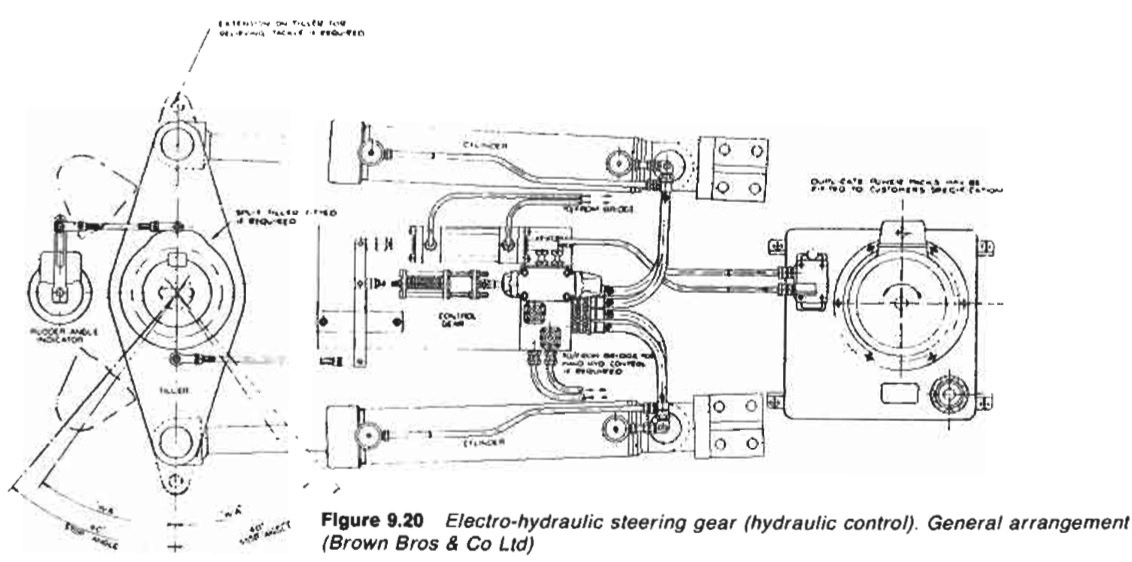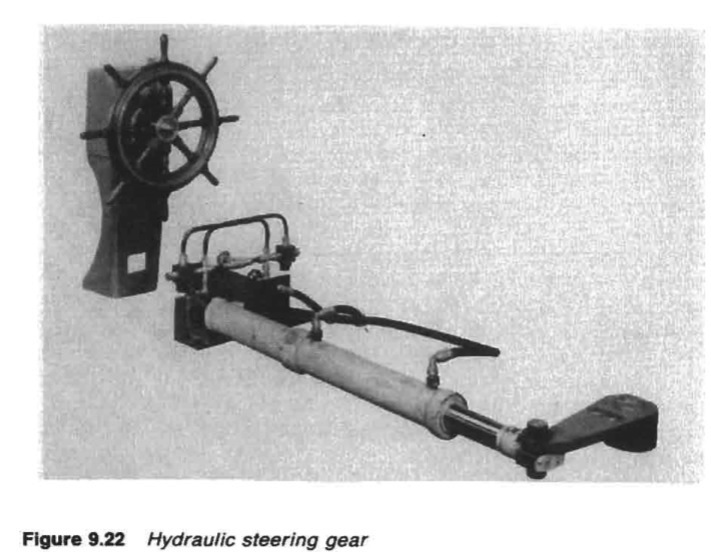
Home page||Steering gears ||
Small hand and power gears - Ship steering systems
Small hand and power gears:
A simpler variant of the electro-hydraulic gear, for small ships requiring rudder
torques below say, 150 kNm is shown in Figure 9.20. The hydraulic circuit is
shown diagrammatically in Figure 9.21.

Figure : Electro hydraulic steering gear control
The rams (U) in the double-acting steering cylinders G, which are free to
oscillate on chocked trunnions, are linked directly to the tiller. F is a
double-acting control cylinder, linked to the floating lever V by rod O. J is a
directional control valve linked to the mid point of the floating lever by a
spring link Z. W is the cut-off link from tiller to floating lever. H is a Socking
valve and I a bypass valve.
Valves C, D and S are solenoid controlled. When not energized, C is open
and D is closed to through flow but acts as a bypass between the ends of
control cylinder F when solenoid S is closed. When the solenoids are energized,
C is closed, D and S are open. J is only operative when steering by power.
When steering by hand, C, D and S are not energized. A pump B in the
steering pedestal, coupled to the wheel, deliver fluid under pressure direct to
the steering cylinders G, so moving the tiller in the sense and to the extent
appropriate to the movement of the wheel. There is no hunting action.
To change to power steering, the power pump is started and C, D and S are
energized, i.e. C is closed, D ceases to be a bypass and it connects the steering
pedestal pump to the control cylinder F. S, now open, allows fluid to pass from
the power pump to J, which now comes under the influence of the floating
lever. Steering-wheel movement now moves the piston in F, the floating lever
pivots on its attachment to W, and J opens to allow the power pump to
discharge to the appropriate ends of the steering cylinders G. As the tiller
moves, a hunting movement occurs, the cut-off link W acting on the floating
lever which, pivoting on its attachment to O, closes I and brings the gear to
rest with the rudder at the angle required.
Rudder angle indicators, either mechanically linked or electrically powered,
are fitted as required. For local control, the ends of the control cylinder are
made common by opening a bypass valve and the control piston is moved by a
hand lever (shown dotted) or, for example, by wheel, rack and pinion. It will be
seen that in the off-loaded condition, the pump discharge circulates through J.
Emergency steering is by relieving tackles, fitted when the rudder is locked
by closure of the valves H.
If hand steering only is required, the gear is reduced to tiller, cylinders and
rams, locking and bypass valves, rudder indicator and steering pedestal with
pump. A simple form of this gear for torques below 11 kNm is shown in Figure
9,22.

Figure : Hydraulic steering gear
Summarized below various ship steering gears general guideline:
- Ship Steering gear failures and safeguards
The hydraulic circuit incorporates an arrangement of stop and bypass valves in the chest VC, which enable the gear to be operated on all four or on any two adjacent cylinders but not with two diagonally disposed cylinders.
......
- Four-ram electro-hydraulic steering gear mechanism
The hydraulic circuit incorporates an arrangement of stop and bypass valves in the chest VC, which enable the gear to be operated on all four or on any two adjacent cylinders but not with two diagonally disposed cylinders.
......
- Enclosed hunting gear
The light construction of the combined control and hunting gears is possible
because the forces concerned are moderate. The self-contained unit is
self-lubricating, and contained in an oil-tight case.
......
- Ship steering control mechanism- use of Hydraulic telemotor
The telemotor has become, on many vessels, the stand-by steering control
mechanism, used only when the electric or automatic steering fails. It comprises
a transmitter on the bridge and a receiver connected to the steering gear
variable delivery pump, through the hunting gear.
......
- Two-ram electro-hydraulic steering gear with variable
delivery pumps
An arrangement of a two-ram steering gear with variable
delivery pumps may have a torque capacity of 120-650 kNm.
The cylinders for this gear are of cast steel but the rarns comprise a one-piece
steel forging with integral pins to transmit the movement through cod pieces
which slide in the jaws of a forked tiller end.
......
- Rudder carrier bearing & Steering gear
The rudder carrier bearing takes the weight of the rudder on a
grease lubricated thrust face. The rudder stock is located by the journal
beneath, also grease lubricated
......
- Small hand and power gears - Ship steering systems
A simpler variant of the electro-hydraulic gear, for small ships requiring rudder
torques below say, 150 kNm
......
- Four ram gear with servo-controlled axial cylinder pumps
Variants of the servo-controlled swash plate axial cylinder pump
are capable of working at 210 bar. Each pump is complete with its own torque
motor, servo-valve, cut-off mechanism, shut-off valve and oil cooler.
......
- Vane type gear - provides security of four ram steering gear
These may be regarded as equivalent to a two-ram gear, with torque capacities
depending on size. An assembly of two rotary vane gears, one above the other,
provides the security of a four ram gear.
......
- Details of two ram hydraulic steering gear arrangement
When the main pumps are at no-stroke, the auxiliary pumps dischar.
to the reservoir via a pressure-limiting valve PC20, set at 20 bar, and to t
pump casings. When the main pumps are on-stroke, the auxiliary pump
discharge to the main pump suction.
......
Home page||Cooling ||Machinery||Services ||Valves ||Pumps ||Auxiliary Power ||Propeller shaft ||Steering gears ||Ship stabilizers||Refrigeration||Air conditioning ||Deck machinery||Fire protection||Ship design
||Home ||
General Cargo Ship.com provide information on cargo ships various machinery systems -handling procedures, on board safety measures and some basic knowledge of cargo ships that might be useful for people working on board and those who working in the terminal. For any remarks please
Contact us
Copyright © 2010-2016 General Cargo Ship.com All rights reserved.
Terms and conditions of use
Read our privacy policy|| Home page||

